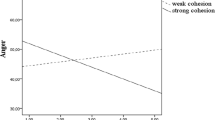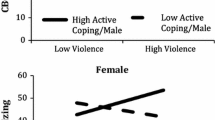Abstract
An ecological stress process model was employed to explore relations between children’s exposures to family and community violence and child mental health, and emotionally-regulated coping (ERC) as a protective factor among Latino, European–American, and African–American school-aged children (n = 91; girls, n = 50[54 %]) living in single-parent families who were either homeless and residing in emergency shelters or housed but living in poverty. Mothers reported domestic violence experiences and their child’s history of physical/sexual abuse, community violence exposures, and mental health. Children reported on exposure to community violence, internalizing symptoms, and coping. The mental health impacts of multi-level violence exposures and ERC as a moderator of associations between violence exposures and child mental health was tested with structural equation modeling. Family abuse was uniquely associated with PTSD, and community violence with anxiety and aggression. Latent interaction tests revealed that ERC moderated relations between family abuse and anxiety, aggression and PTSD. Emotionally-regulated coping appears to play a protective role for children’s mental health in contexts of violence exposure, offering opportunities for intervention and prevention.



Similar content being viewed by others
References
Achenbach, T. M. (1991). Integrative guide for the 1991 CBCL/4-18, YSR and TRF profiles. Burlington: Department of Psychiatry, University of Vermont.
Achenbach, T. M., & Rescorla, L. A. (2007). Multicultural Supplement to the Manual for the ASEBA School-Age Forms & Profiles. Burlington: University of Vermont, Research Center for Children, Youth, & Families.
Aiken, L. S., & West, S. G. (1991). Multiple regression: Testing and interpreting interactions. Newbury Park: Sage.
Aldwin, C., Skinner, E., Zimmer-Gembeck, M., & Taylor, A. (2011). Coping and self-regulation across the life-span. In Fingerman (Ed.). 563–589.
Ayers, T. S., Sandler, I. N., West, S. G., & Roosa, M. W. (1996). A dispositional and situational assessment of children’s coping: testing alternative models of coping. J Pers, 64, 923–958.
Barrow, S., Hellman, F., Lovell, A., Plapinger J., Robinson D., & Struening E. (1985). Personal history form. New York: New York State Psychiatric Institute.
Bassuk, E. L., Weinreb, L. F., Buckner, J. C., Browne, A., Salomon, A., & Bassuk, S. S. (1996). The characteristics and needs of sheltered homeless and low-income housed mothers. J Am Med Assoc, 276, 640–646.
Brady, S. S., Gorman-Smith, D., Henry, D. B., & Tolan, P. H. (2008). Adaptive coping reduces the impact of community violence exposure on violent behavior among African American and Latino male adolescents. J Abnorm Child Psychol, 36, 105–115.
Browne, M. W., & Cudeck, R. (1993). Alternative ways of assessing model fit. In K. A. Bollen & J. S. Long (Eds.), Testing structural equation models. Newbury Park: Sage.
Buckner, J., Mezzacappa, E., & Beardslee, W. (2003). Characteristics of resilient youths living in poverty: the role of self-regulatory processes. Dev Psychopathol, 15, 139–162.
Buckner, J. C., Beardslee, W. R., & Bassuk, E. L. (2004). Exposure to violence and low-income children’s mental health: direct, moderated, and mediated relations. Am J Orthopsychiatry, 74, 413–423.
Chan, Y., & Yeung, J. (2009). Children living with violence within the family and its sequel: a meta-analysis from 1995–2006. Aggress Violent Behav, 14, 313–322.
Chou, C. P., & Bentler, P. M. (1990). Model modification in covariance structure modeling: a comparison among the likelihood ratio, Lagrange Multiplier, and Wald tests. Multivar Behav Res, 25, 115–136.
Cicchetti, D., & Toth, S. L. (2005). Child maltreatment. Annu Rev Clin Psychol, 1, 409–438.
Clarke, A. (2006). Coping with interpersonal stress and psychosocial health among children and adolescents: A Meta-Analysis. J Youth Adolesc, 35, 11–24.
Compas, B., O’Connor-Smith, J. K., Saltzman, S., Thomsen, A. H., & Wadsworth, M. E. (2001). Coping with stress during childhood and adolescence: problems, progress, and potential in theory and research. Psychol Bull, 127, 87–127.
Cummings, E. M., El-Sheikh, M., Kouros, C. D., & Buckhalt, J. A. (2009). Children and violence: the role of children’s regulation in the marital aggression child adjustment link. Clin Child Fam Psychol Rev, 12, 13–15.
Dempsey, M., Overstreet, S., & Moely, B. (2000). “Approach” and “avoidance” coping and PTSD symptoms in inner-city youth. Curr Psychol: Dev, Learn, Personal, Soc, 19, 28–45.
Egeland, B., Yates, T., Appleyard, K., & van Dulmen, M. (2002). The long-term consequences of maltreatment in the early years: a developmental pathway model to antisocial behavior. Child Serv: Soc Pol, Res, & Pract, 5, 249–260.
Eisenberg, N., & Silver, R. (2011). Growing up in the shadow of terrorism: youth in America after 9/11. Am Psychol, 66, 468–481.
Eisenberg, N., Fabes, R., & Guthrie, I. (1997). Coping with stress: the roles of regulation and development. In S. A. Wolchik & I. N. Sandler (Eds.), Handbook of children’s coping: linking theory, research and interventions (pp. 41–70). New York: Plenum Press.
Eisenberg, N., Hofer, C., & Vaughan, J. (2007). Effortful control and its socioemotional consequences. In J. J. Gross (Ed.), Handbook of emotion regulation (pp. 287–306). New York: Guilford Press.
Finkelhor, D., Turner, H., Ormrod, R., Hamby, S. & Kracke, K. (2009). Children’s exposure to violence: A comprehensive national survey. Office of Juvenile Justice, US Department of Justice October, 2009.
Folkman, S., & Moskowitz, J. T. (2004). Coping: pitfalls and promise. Annu Rev Psychol, 55, 745–774.
Fosco, G., DeBoard, R., & Grych, J. (2007). Making sense of family violence: implications of children’s appraisals of interparental aggression for their short- and long-term functioning. Eur Psychol, 12, 6–16.
Foster, H., & Brooks-Gunn, J. (2009). Toward a stress process model of children’s exposure to physical family and community violence. Clin Child Fam Psychol Rev, 12, 71–94.
Grant, K. E., & Compas, B. E. (1995). Stress and symptoms of depression/anxiety among adolescent: searching for mechanisms of risk. J Consult Clin Psychol, 63, 1015–1021.
Grant, K. E., O’Koon, J. H., Davis, T. H., Roache, N. A., Poindexter, L. M., Armstrong, M. L., et al. (2000). Protective factors affecting low-income urban African American youth exposed to stress. J Early Adolesc, 20, 388–417.
Hanson, R., Self-Brown, S., Fricker-Elhai, A., Kilpatrick, D., Saunders, B., & Resnick, H. (2006). Relations among parental substance use, violence exposure and mental health: the national survey of adolescents. Addict Behav, 31, 1988–2001.
Hu, L., & Bentler, P. M. (1999). Cutoff criteria for fit indexes in covariance structure analysis: conventional criteria versus new alternatives. Struct Equ Model, 6, 1–55.
Kearney, C., Wechsler, A., Kaur, H., & Lemos-Miller, A. (2010). Posttraumatic stress disorder in maltreated youth: a review of contemporary research and thought. Clin Child Fam Psychol Rev, 13, 46–76.
Kliewer, W., & Sullivan, T. (2008). Community violence exposure, threat appraisal, and adjustment in adolescents. J Clin Child Adolesc Psychol, 37, 860–873.
Kliewer, W., Parrish, K., Taylor, K., Jackson, K., Walker, J., & Shivy, V. (2006). Socialization of coping with community violence: influences of caregiver coaching, modeling, and family context. Child Dev, 77, 605–623.
Lazarus, R. S., & Folkman, S. (1984). Stress, appraisal, and coping. New York: Springer.
Little, T. D. (2011). Longitudinal structural equation modeling. New York: Guilford press.
Lynch, M. (2003). Consequences of children’s exposure to community violence. Clin Child Fam Psychol Rev, 6, 265–266.
Margolin, G., & Gordis, E. B. (2000). The effects of family and community violence on children. Annu Rev Psychol, 51, 445–479.
Masten, A. S., Neeman, J., & Andenas, S. (1994). Life events and adjustment in adolescents: the significance of event independence, desirability, and chronicity. J Res Adolesc, 4, 71–97.
Muthen, L. K., & Muthen, B. O. (2007). Mplus User’s Guide (5th ed.). Los Angeles: Muthen & Muthen.
Pearlin, L. I. (1999). The stress process revisited: Reflections on concepts and their interrelationships. In C. S. Anenshensel & J. C. Phelan (Eds.), Handbook of the sociology of mental health (pp. 395–415). New York: Kluwer.
Pina, A. A., Little, M., Knight, G. P., & Silverman, W. K. (2009). Cross-ethnic measurement equivalence of the RCMAS in Latino and White youth with anxiety disorders. J Pers Assess, 91, 58–61.
Preacher, K. J., Curran, P. J., & Bauer, D. J. (2006). Computational tools for probing interaction effects in multiple linear regression, multilevel modeling, and latent curve analysis. J Educ Behav Stat, 31, 437–448.
Reynolds, C. R., & Richmond, B. O. (1985). Revised Children’s Manifest Anxiety Scale. RCMAS Manual. Los Angeles: Western Psychological Services.
Ryan-Wenger, N. M. (1990). Development and psychometric properties of the schoolager’s coping strategies inventory. Nurs Res, 39, 346–349.
Sandler, I. N. (2001). Qualities and ecologies of adversity as common mechanism of risk and resilience. Am J Community Psychol, 29, 19–61.
Sandler, I. N., Tein, J., Mehta, P., Wolchik, S., & Ayers, T. (2000). Coping efficacy and psychological problems of children of divorce. Child Dev, 71, 1099–1118.
Straus, M. A. (1979). Measuring intrafamily conflict and violence: the conflict tactics (ct) scales. J Marriage Fam, 41, 75–88.
Tolan, P., Gorman-Smith, D., & Henry, D. (2006). Family violence. Annu Rev Psychol, 57, 557–583.
Wolfe, V. V., Gentile, C., & Wolfe, D. A. (1989). The impact of sexual abuse on children: a PTSD formulation. Behav Ther, 20, 215–228.
Yates, T. M., Dodds, M. F., Sroufe, L. A., & Egeland, B. (2003). Exposure to partner violence and child behavior problems: a prospective study controlling for child physical abuse and neglect, child cognitive ability, socioeconomic status, and life stress. Dev Psychopathol, 15, 199–218.
Author Note
This study was based on secondary analysis of data archived by the Murray Center for the Study of Lives, Harvard University, from the Worcester Family Research Project conducted by the National Center on Family Homelessness and the University of Massachusetts Medical Center at Worcester with funding from the National Institute of Mental Health (NIMH) and the U.S. Maternal and Child Health Bureau. We are indebted to the families and children who participated in the Worcester Family Research Project. We also thank Debra Gustafson, Kristopher Preacher, Ista Zahn and Howard Crumpton for their support and assistance with data preparation and analyses, including measurement modeling and latent interaction tests focusing on children’s own experiences of coping effectiveness.
Conflict of Interest
The authors declare that they have no conflict of interest.
Author information
Authors and Affiliations
Corresponding author
Rights and permissions
About this article
Cite this article
Mohammad, E.T., Shapiro, E.R., Wainwright, L.D. et al. Impacts of Family and Community Violence Exposure on Child Coping and Mental Health. J Abnorm Child Psychol 43, 203–215 (2015). https://doi.org/10.1007/s10802-014-9889-2
Published:
Issue Date:
DOI: https://doi.org/10.1007/s10802-014-9889-2




